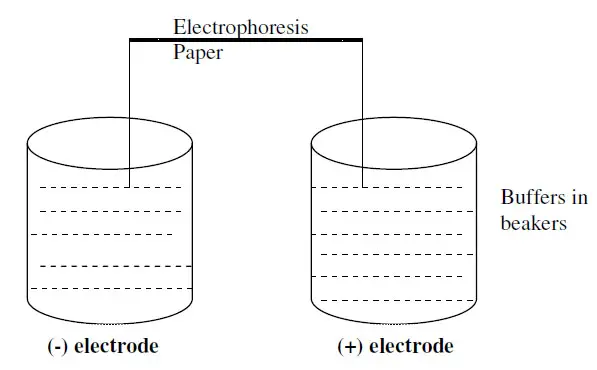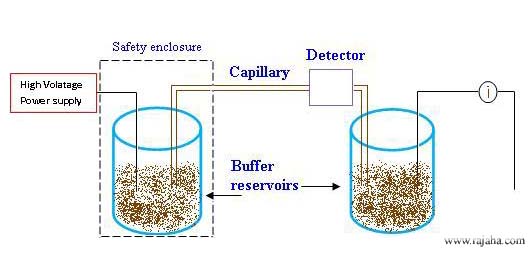Electrophoresis is one of the widely used techniques in molecular biochemistry, microbiology, biomedical research.
It is a type of protein separation method which relies on protein sizes to segregate the mixture.
It is one of the highly effective analysis techniques and the sole method for the separation of proteins for western blot, RNA studies, etc.
On the negative side, it is also a time-consuming, expensive, and technical skilled procedure that is less preferred in health care.
It is both a qualitative and quantitative analysis technique.
Electrophoresis is similar to other separation techniques like chromatography, but it differs regarding the types of samples analyzed, the method used for separation, the principle used, etc.
Definition and Electrophoresis Principle
The term Electrophoresis means Electro=electric field + Phoresis=migration. So as the name indicates,
- “electrophoresis is a method of separation wherein charged molecules migrate in differential speeds in an applied electric field.“
- The charged molecules under the influence of the electric field migrate towards oppositely charged electrodes.
- Those molecules with a +ve charge move towards the cathode and -ve molecules move towards Anode.
- The migration is due to the charge on the molecules and potentially applied across the electrodes.
- The sample under test is placed at one end of the paper near one of the electrodes.
- When electricity is applied, the molecules start moving to their respective electrodes.
- But the movement is influenced by the molecular weight of the molecule.
So when a mixture is placed on the agarose gel, different bands are seen along with the gel after the process.

- This is due to the differential rate of movement by molecules based on their weight.
- Those molecules with higher molecular weight move slower.
- At the same time, those with small weights run faster.
- Also, the size of the molecule also influences the movement.
- The bigger size molecule experience more friction than smaller ones in motion.
- These molecules migrate at different speeds and to different lengths based on their charge, mass, and shape.
Types of electrophoresis & their techniques.
Electrophoresis can be broadly divided into two types as
- Slab electrophoresis
- Capillary electrophoresis.
The slab method is the classical method that is widely used on an industrial scale. It is slow, time-consuming, and bulky. Still, it is the sole method for separating proteins like enzymes, hormones, antibodies, and nucleotides like DNA and RNA.
This slab electrophoresis is further divided into three types based on the principle used for separation.
a. Zone electrophoresis
b. Isoelectric focusing
c. Immune-electrophoresis.
Zone electrophoresis: Here, the charged particles are separated into different zones or bands. This is of two types as
- Paper electrophoresis.
- Gel Electrophoresis.
Paper electrophoresis
- This technique employs a Whatman filter paper No.1 for the process.
- This paper is moistened by a buffer and then connected at two ends to two oppositely charged electrodes.
- Then the sample is applied to one end and let for separation of components under electric gradients.
- After separation, the paper is dried and stained to get colored bands.
- These colored bands are recognized for the nature of the sample by comparing it with the standard.
For a sample of serum, five bands of proteins can be separated by paper electrophoresis.
Gel electrophoresis
- This is a similar technique wherein instead of paper, a gel is made of agarose or SDS (sodium dodecyl sulfate).

- The separation is more efficient than paper type as the rate of the running of molecules is slow and the area of separation is larger by thickness.
- The sample is applied and subjected to an electric field which can lead to the separation of molecules.
- These molecules form bands and can be recognized by staining and comparing them with standard sample bands.
The method is more effective than paper and for instance, 15 protein bands can be isolated from a serum sample.
Isoelectric-focusing
- Here the isoelectric pH is set at different foci and hence the molecules are immobilized to their isoelectric point.
- They don’t move towards electrodes but stay at a specific isoelectric pH.
- This is even more efficient to separate proteins, and from serum, 40 bands of protein can be formed.
Immunoelectrophoresis
- This is the method with the combination of principles of both electrophoreses with immune reactions.
- First, the proteins are separated onto the electrophoresis paper.
- Then the antibodies are allowed to diffuse through the paper and react with separated protein molecules in bands.
Also, read other immunoassay reactions for a better idea.
♣ Principle and types of ELISA. ♣ Radioimmunoassay.
Both of the methods are very specific and highly sensitive and widely used in microbiology.
Capillary electrophoresis
- As the name indicates, here, the process of separation takes place inside a capillary tube.
- Capillary electrophoresis is an advanced method of electrophoresis.
- This was developed with the intent to minimize the time taken for separation and analysis in slab electrophoresis.
- This capillary electrophoresis requires a small sample in the range of 0.1 to 10 ηl while the slab method requires an μl range.
- Also, this method yields high-speed and high-resolution separations.
- Besides, the separated components which exit from one end of the capillary are immediately analyzed by detectors fixed at the end of tubes.
The instrumentation is as below.
Applications of electrophoresis
1. To separate complex biological molecules
- Many complex biological molecules like vitamins B12.
2. Antibiotics, proteins can be separated efficiently by electrophoresis.
- This is possible due to the charge difference among the mixtures.
3. For analysis of nucleic acids like RNA and DNA studies.
- These long-chain molecules can be analyzed only after a separation after electrophoresis.
- This helps to determine the size of breaks in the DNA or RNA molecule.
Also, read the Difference between Chromatography and Electrophoresis.

Thanks a lot
Nice article i really appreciate it thanks
WHAT IS THE PRINCIPLE OF ELECTROPHORESIS BASED ON?
Relative order of paper chromatography RF valves for the amino acid in this mixtures Ser,Lys,Leu,Val,and Ala.Assumed that the developing solvent is n-butanol,water,and acetic acid?
@ABEL HAWUSE! We did work on alkaloids using paper chromatography never on amino-acids. So can’t say..regards
nice assay, with good grammatic usage.
Does electrophoreses treats lymphedema
and low back pain?
A good article for them who r studing physiology or biotechnology as well as biochemistry!
nice article I used it for my assignment
Hi, author! you made interesting and fantastic work. Hope you will do beyond that because we expect more from you. Keep it up!!!!!!!!
what is steady state electrophoresis
What is a difference b/w chromatography n electrophoresis?
electrophoresis is the “chromatographical’ separation of molecules by use of their differential rate of movements under the influence of an electric field. it simply means without an electric field electrophoresis becomes chromatography
wooow I have really enjoyed,….thanks so much….very right
Really helpful
what’s moving boundary or free solution electrophoresis
An adequate information with nice understanding words……
Hb electrophorosis is which type of electrophoresis
@ sangita baad! It comes under gel electrophoresis.
what of the applications of electrophoresis please?
@magetorobert!Included in the article.thanks for stopping by..
what is epi on electrophorisis ?
Hi amit! The term ‘epi’ mostly means above or on the top side or surface. In electrophoresis epi-optical systems are used to detect from one side of the electrophoresis developed paper.